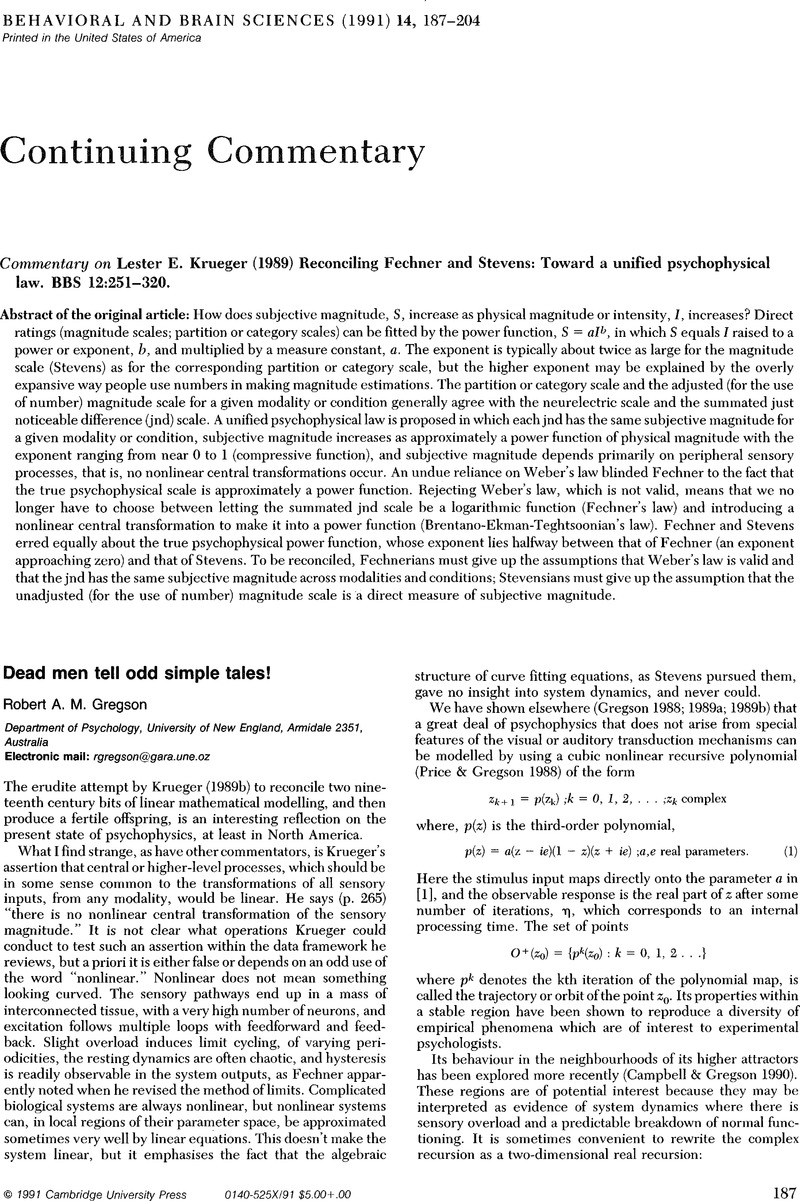Crossref Citations
This article has been cited by the following publications. This list is generated based on data provided by Crossref.
Hornstein, Gail A.
1993.
The chimera of psychological measurement.
Behavioral and Brain Sciences,
Vol. 16,
Issue. 1,
p.
148.
Murray, David J.
1993.
The place of psychophysics in the history of sensory science.
Behavioral and Brain Sciences,
Vol. 16,
Issue. 1,
p.
166.
Ross, Helen E.
1993.
Unwarranted popularity of a power function for heaviness estimates.
Behavioral and Brain Sciences,
Vol. 16,
Issue. 1,
p.
159.
Gigerenzer, Gerd
1993.
From metaphysics to psychophysics and statistics.
Behavioral and Brain Sciences,
Vol. 16,
Issue. 1,
p.
139.
Treisman, Michel
1993.
Psychophysics and the mind-brain problem.
Behavioral and Brain Sciences,
Vol. 16,
Issue. 1,
p.
162.
Anderson, Norman H.
1993.
Nonconscious sensation and inner psychophysics.
Behavioral and Brain Sciences,
Vol. 16,
Issue. 1,
p.
137.
Gregson, Robert A. M.
1993.
The head and tail of psychophysical algebra.
Behavioral and Brain Sciences,
Vol. 16,
Issue. 1,
p.
141.
Heidelberger, Michael
1993.
Fechner's impact for measurement theory.
Behavioral and Brain Sciences,
Vol. 16,
Issue. 1,
p.
146.
Laming, Donald
1993.
The antecedents of signal detection theory.
Behavioral and Brain Sciences,
Vol. 16,
Issue. 1,
p.
151.
Borg, Gunnar
1993.
A perspective on psychophysics is not derived just from the history of psychophysicists.
Behavioral and Brain Sciences,
Vol. 16,
Issue. 1,
p.
138.
Weiss, David J.
1993.
Looking backward: Progress in outer psychophysics.
Behavioral and Brain Sciences,
Vol. 16,
Issue. 1,
p.
165.
Murray, David J.
1993.
A perspective for viewing the history of psychophysics.
Behavioral and Brain Sciences,
Vol. 16,
Issue. 1,
p.
115.
Marks, Lawrence E.
1993.
Quantifying, valuing, choosing.
Behavioral and Brain Sciences,
Vol. 16,
Issue. 1,
p.
156.
Lebedev, Artour N.
1993.
Derivation of Stevens's exponent from neurophysiological data.
Behavioral and Brain Sciences,
Vol. 16,
Issue. 1,
p.
152.
van Brakel, J.
1993.
The analysis of sensations as the foundation of all sciences.
Behavioral and Brain Sciences,
Vol. 16,
Issue. 1,
p.
163.
Stout, Dale A.
1993.
Bedrock metaphysics, fossil fuel psychophysics.
Behavioral and Brain Sciences,
Vol. 16,
Issue. 1,
p.
160.
Link, Stephen
1993.
Fechner's theory of mental measurement.
Behavioral and Brain Sciences,
Vol. 16,
Issue. 1,
p.
153.
Gundlach, Horst
1993.
Psychophysics, its history and ontology.
Behavioral and Brain Sciences,
Vol. 16,
Issue. 1,
p.
144.
Whittle, Paul
1993.
A perspective for viewing the present of psychophysics.
Behavioral and Brain Sciences,
Vol. 16,
Issue. 1,
p.
165.
Krueger, Lester E.
1993.
History of psychophysics: Some unanswered questions.
Behavioral and Brain Sciences,
Vol. 16,
Issue. 1,
p.
149.





